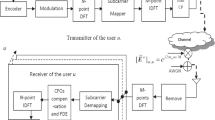Abstract
High peak to average power ratio (PAPR) of OFDM reduces the transmitter power efficiency and increases the complication in hardware implementation. A number of techniques have been developed to minimize PAPR of OFDM. Among these techniques, iterative clipping and filtering (ICF) is an effective recent technique that produces significant results in minimizing PAPR. But, the major limitation of this approach is that it requires several iterations for minimizing PAPR. In order to overcome the above limitation, an optimization based ICF is used in this research work. An efficient custom optimized adaptive clipping and filtering technique is proposed. The proposed method shows a greater reduction in PAPR in lesser iterations with reduced out-of-band distortion and bit error rate when compared over classical clipping techniques. Moreover, the effects of oversampling on the performance of the proposed OFDM system are also evaluated.














Similar content being viewed by others
References
Nakhai, M. R. (2008). Multicarrier transmission. IET Signal Processing, 2(1), 1–14.
Zhu, X., Jiang, T., & Zhu, G. (2008). Novel schemes based on Greedy algorithm for PAPR reduction in OFDM systems. IEEE Transactions on Consumer Electronics, 54(3), 1048–1052.
Noman, K., Islam, M., Azam, S., & Khan, N. H. (2013). Comparative study between selection mapping technique (SLM) and partial transmission sequence (PTS) for PAPR reduction in OFDM signals. International Journal of Advanced Research in Computer and Communication Engineering, 2(11), 4459–4463.
Wang, Z. (2010). Reduction PAPR of OFDM signals by combining SLM with DCT transform. International Journal of Communications, Network and System Sciences (Vol. 3, pp. 888–892). doi:10.4236/ijcns.2010.311120. Published Online November (http://www.SciRP.org/journal/ijcns).
Han, S. H., Cioffi, J. M., & Lee, J. H. (2008). On the use of hexagonal constellation for peak-to-average power ratio of an OFDM signal. IEEE Transactions on Wireless Communications, 7(3), 781–786.
Armstrong, J. (2001). New OFDM peak-to-average power reduction scheme. Vehicular technology conference, IEEE, 1, 756–760.
Sehgal, A., & Kohli, A. (2013). OFDM-PAPR reduction using statistical clipping and window based noise filtering. Electronic theses and dissertations, 27 Aug 2013.
Wang, L., & Tellambura, C. (2005). A simplified clipping and filtering technique for PAR reduction in OFDM systems. IEEE Signal Processing Letters, 12(6), 453–456.
Wang, Y.-C., & Luo, Z. (2011). Optimized iterative clipping and filtering for PAPR reduction of OFDM signals. IEEE transactions on communications, 59(1), 33–37.
Lee, B. M., & Kim, Y. (2012). An adaptive clipping and filtering technique for PAPR reduction of OFDM signals. Circuits, Systems and Signal Processing, 32(3), 1335–1349.
Nader, C., Händel, P., & Björsell, N. (2010). OFDM PAPR reduction by convex optimization: A power amplifier point-of-view. In: IEEE international microwave workshop series on RF front-ends for software defined and cognitive radio solutions (IMWS) (pp. 1–4).
Liu, Q., Baxleyand, R., & Zhou, G. T. (2008). Error vector magnitude optimization for OFDM systems with a deterministic peak-to-average power ratio constraint. In: Proceedings of IEEE International Conference on Information Science Systems, Princeton, NJ, USA (pp. 101–104).
Sharif, M., Gharavi-Alkhansari, M., & Khalaj, B. H. (2003). On the peak-to-average power of OFDM signals based on oversampling. IEEE Transactions on communications, 51(1), 72–78.
Devlin, C. A., Zhu, A., & Brazil, T. J. (2008). Peak to average power ratio reduction technique for OFDM using pilot tones and unused carriers. In Radio and wireless symposium, IEEE 2008 (pp. 33–36).
Sezginer, S., & Sari, H. (2007). Metric-based symbol predistortion techniques for peak power reduction in OFDM systems. IEEE Transactions on Wireless Communications, 6(7), 2622–2629.
Yoo, H., Guilloud, F., & Pyndiah, R. (2011). Low complexity SLM technique with an interleaver-butterfly ensemble for PAPR reduction of power limited OFDM system. In Vehicular technology conference (VTC Spring), 2011 IEEE 73rd (pp. 1–5).
Singh, K., Bharti, M. R., & Jamwal, S. (2012). A modified PAPR reduction scheme based on SLM and PTS techniques. In: Signal processing, computing and control (ISPCC), IEEE international conference on 2012 (pp. 1–6).
Maha, G. A. M., Ghouz, H. H. M., & Hussien, N. M. (2012). Novel PAPR reduction technique based on conventional partial transmit sequence (PTS). International Journal of Engineering and Technology IJET-IJENS, 12(06).
Han, S. H., & Lee, J. H. (2005). An overview of peak-to-average power ratio reduction techniques for multi carrier transmission. IEEE Wireless Communications, 12(2), 56–65.
Armstrong, J. (2002). Peak-to-average power reduction for OFDM by repeated clipping and frequency domain filtering. Electronics Letters, 38(5), 246–247.
Ochiai, H., & Imai, H. (2002). Performance analysis of deliberately clipped OFDM signals. IEEE Transactions on Communications, 50(1).
Aggarwal, A., & Meng, T. (2006). Minimizing the peak-to-average power ratio of OFDM signals using convex optimization. IEEE Transactions on Signal Processing, 54(8), 3099–3110.
Luo, Z. Q., & Yu, W. (2006). An introduction to convex optimization for communications and signal processing. IEEE Journal of Selected Areas Communications, 24(8), 1426–1438.
Wang, C., & Leung, S. H. (2008). PAR reduction in OFDM through convex programming. IEEE.
Leung, S. H., & Wang, C. (2008). Par reduction in OFDM through convex programming. In Proceedings of IEEE international conference on acoustics, speech, signal processing, Las Vegas, NV, USA (pp. 3597–3600).
Luo, Z.-Q., & Yu, W. (2006). An introduction to convex optimization for communications and signal processing. IEEE Journal on Selected Areas in Communications, 24(8), 1426–1438.
Grant, M., & Boyd, S. (2008). CVX: Matlab software for disciplined convex programming (web page and software). (Online). http://stanford.edu/boyd/cvx.
Nandalal, V., & Sophia, S. (2012). An iterative statistical dispersion based clipping and conic optimized filtering for a swift lowering of PAPR in OFDM systems. European Journal of Scientific Research, 92(1), 56–63.
Acknowledgments
Our thanks to the experts who have contributed towards the development of this paper.
Author information
Authors and Affiliations
Corresponding author
Rights and permissions
About this article
Cite this article
Nandalal, V., Sophia, S. PAPR Reduction of OFDM Signal via Custom Conic Optimized Iterative Adaptive Clipping and Filtering. Wireless Pers Commun 78, 867–880 (2014). https://doi.org/10.1007/s11277-014-1788-x
Published:
Issue Date:
DOI: https://doi.org/10.1007/s11277-014-1788-x




